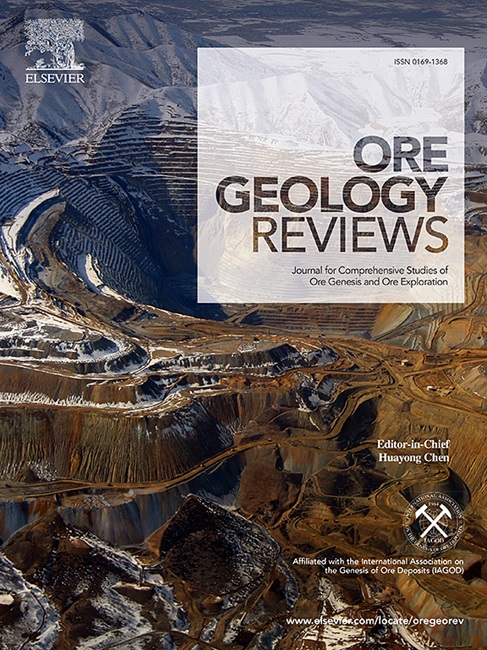Trace element geochemistry and genetic implications of sphalerite and pyrite from the Lower Cambrian Dahebian stratiform barite deposit and its associated deep-seated sulfide mineralization, South China
IF 3.2
2区 地球科学
Q1 GEOLOGY
引用次数: 0
Abstract
The southeastern margin of the Yangtze Block hosts significant stratiform barite deposits within the early Cambrian black shales. Various models, including submarine exhalative hydrothermal activity, cold seep, and biological enrichment, have been proposed to explain their genetic types. Recently, substantial Zn-Pb-Fe sulfide ores mainly hosted by the Doushantuo Formation were discovered beneath the early Cambrian stratiform barite ores. The sulfide and barite ores along this belt demonstrated a common characteristic of close spatial relationship; however, it remains unclear whether a genetic relationship also exists. Nevertheless, this shed newly light on to decoding the genetic mechanism of massive barite deposition during this period. The mineralogy and trace element concentrations of sphalerite and pyrite in both deep-seated sulfide ores and stratiform barite ores at the Dahebian region were determined in this study. Hyalophane intergrown with apatite was frequently observed in both types of ores. This association contrasts with the Mississippi Valley Type (MVT) zinc-lead mineralization hosted in the Qinxudong Formation within this region, where apatite is predominantly surrounded by hydrothermal calcite. Furthermore, a covariant trend of minor concentrations of sphalerite and/or pyrite has been observed between sulfide ores and barite ores, indicating their precipitation within evolving hydrothermal fluids. This observation is corroborated by the decreasing temperatures of sphalerite during precipitation: the early-stage sulfide mineralization, late-stage mineralization, and stratiform barite deposit have recorded hydrothermal fluid temperatures in the ranges of 109 °C to 235 °C, 99 °C to 231 °C, and 38 °C to 199 °C, respectively. Furthermore, a comparable decreasing trend in sulfur fugacities was observed during the transition from sulfide to barite ore mineralization. The elevated concentrations of Ni, Cu, Se, and V in the late-stage pyrite of deep-seated sulfide deposits suggest that anoxic-euxinic bottom seawater infiltration along extensional faults likely facilitated mineralization. The enhanced influx of infiltrating seawater into mineralization zones significantly reduced the temperature of hydrothermal fluids, leading to a decrease in the rates of thermochemical sulfate reduction. Therefore, it can be reasonably inferred that the sulfide ore underlying the stratiform barite ores likely originated from sedimentary exhalative hydrothermal fluids. The Zn-Pb-Fe sulfide ores, which are deeply seated, underwent mineralization within the feeder zone at depth. Conversely, the stratiform barite deposits represent the uppermost expression of sedimentary-exhalative mineralization. These findings collectively suggest intense venting of Zn-Pb-Fe-Ba-bearing hydrothermal fluids into the rift basin along the southeastern margin of the Yangtze Block during the early Cambrian period.

华南下寒武统大河边层状重晶石矿床及其伴生深部硫化物矿化闪锌矿和黄铁矿微量元素地球化学特征及成因意义
扬子地块东南缘在早寒武世黑色页岩中赋存重要的层状重晶石矿床。人们提出了各种各样的模型来解释它们的遗传类型,包括海底喷出热液活动、冷渗漏和生物富集。近年来,在早寒武统层状重晶石矿床下发现了大量主要赋存于陡山沱组的锌铅铁硫化物矿床。硫化物矿与重晶石矿沿此带呈现出紧密空间关系的共同特征;然而,目前尚不清楚是否也存在遗传关系。然而,这为破解这一时期大块重晶石沉积的成因机制提供了新的思路。测定了大河边地区深层硫化物矿石和层状重晶石矿石中闪锌矿和黄铁矿的矿物学特征及微量元素含量。在这两种矿石中都经常观察到与磷灰石共生的透明玻璃。这种组合与该区秦旭东组的密西西比河谷型(MVT)锌矿化形成对比,后者磷灰石主要被热液方解石包围。此外,在硫化物矿石和重晶石矿石之间观察到少量闪锌矿和/或黄铁矿的协变趋势,表明它们在演化的热液流体中沉淀。降水过程中闪锌矿温度的下降也证实了这一观察结果:早期硫化物成矿作用、晚期成矿作用和层状重晶石矿床的热液温度分别为109℃~ 235℃、99℃~ 231℃和38℃~ 199℃。在硫化物矿化向重晶石矿化转变的过程中,硫逸性也有相应的下降趋势。深部硫化物矿床晚期黄铁矿中Ni、Cu、Se和V的富集表明,缺氧-缺氧的海底海水沿伸展断裂入渗可能促进了成矿作用。入渗海水向矿化带的涌入增强,显著降低了热液流体的温度,导致热化学硫酸盐还原速率降低。因此,可以合理推断层状重晶石矿石下伏的硫化物矿石可能来源于沉积喷发热液。深部锌铅铁硫化物矿在深部给矿带内发生成矿作用。相反,层状重晶石矿床代表了沉积-呼出矿化的最高表现。这些结果表明,早寒武世,扬子地块东南缘裂谷盆地中存在大量含锌、铅、铁、钡的热液。
本文章由计算机程序翻译,如有差异,请以英文原文为准。
求助全文
约1分钟内获得全文
求助全文
来源期刊

Ore Geology Reviews
地学-地质学
CiteScore
6.50
自引率
27.30%
发文量
546
审稿时长
22.9 weeks
期刊介绍:
Ore Geology Reviews aims to familiarize all earth scientists with recent advances in a number of interconnected disciplines related to the study of, and search for, ore deposits. The reviews range from brief to longer contributions, but the journal preferentially publishes manuscripts that fill the niche between the commonly shorter journal articles and the comprehensive book coverages, and thus has a special appeal to many authors and readers.
 求助内容:
求助内容: 应助结果提醒方式:
应助结果提醒方式:


